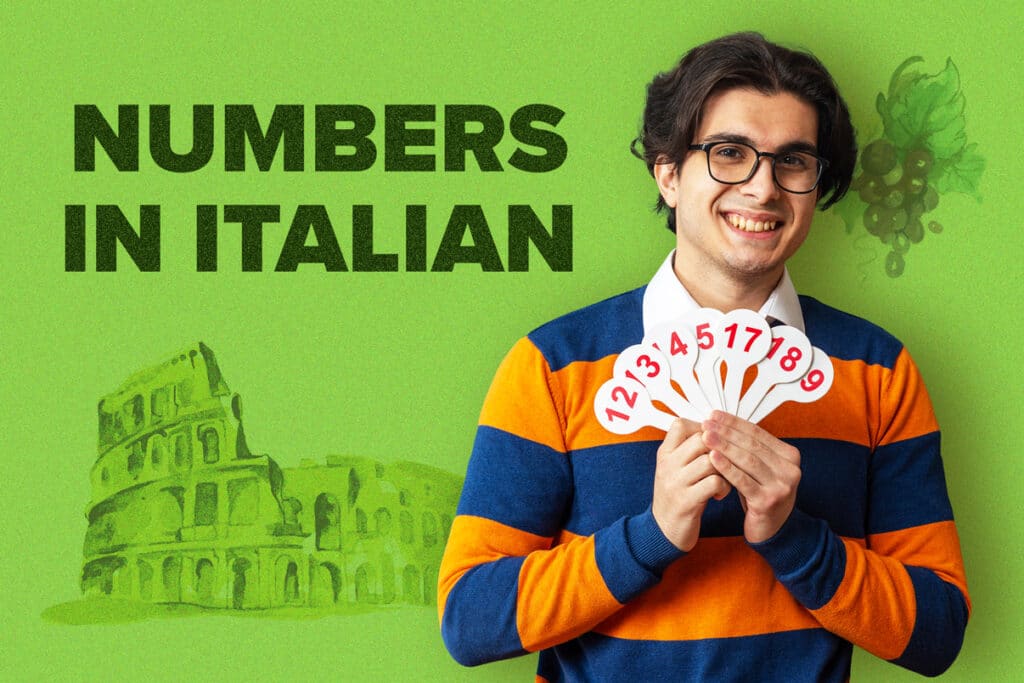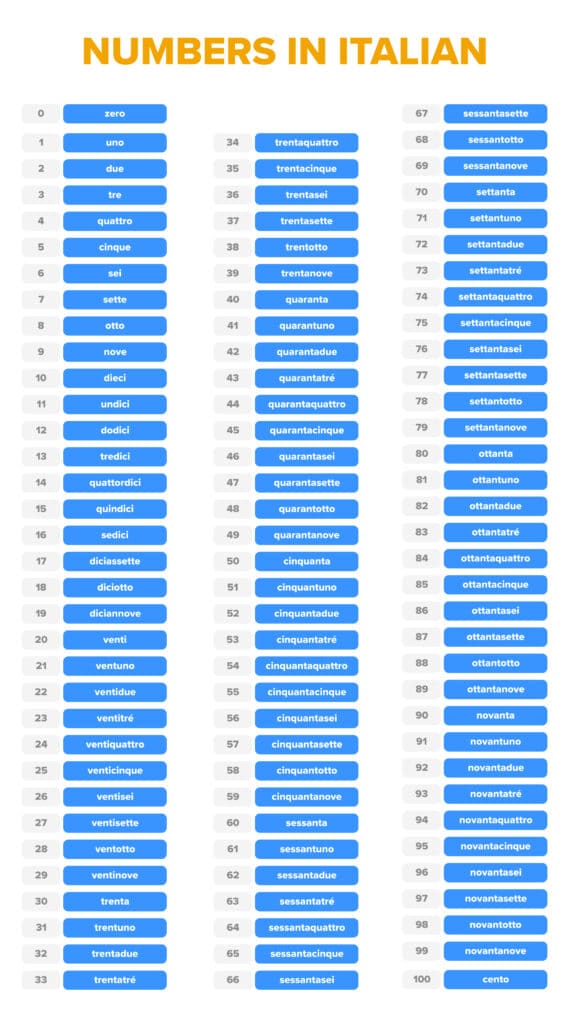
Numbers in Italian from 1-1000 and Beyond: How to Count like a Native Speaker
Numbers do count… a lot!
And knowing Italian numbers (i numeri) is essential for day-to-day, real-life Italian conversations.
This guide will show you exactly how to use numbers in Italian—from zero up to sextillion, with the basics of ordinal numbers included too.
Read on to get the hang of Italian numbers, and practice along with the audio pronunciation!
Contents
- Italian Numbers 1 to 10
- Italian Numbers 11 to 20
- Italian Numbers 30 to 100
- Italian Numbers 101 and Beyond
- Italian Ordinal Numbers
- Notes on Numbers in Italian
- Other Quantities in Italian
- How To Practice Numbers in Italian
- And One More Thing...
Download: This blog post is available as a convenient and portable PDF that you can take anywhere. Click here to get a copy. (Download)
Italian Numbers 1 to 10
| English | Italian |
|---|---|
| 0 | Zero |
| 1 | Uno |
| 2 | Due |
| 3 | Tre |
| 4 | Quattro |
| 5 | Cinque |
| 6 | Sei |
| 7 | Sette |
| 8 | Otto |
| 9 | Nove |
| 10 | Dieci |
Italian Numbers 11 to 20
You’ll have an easier time remembering these numbers if you think of 11 as “1 and 10” combined, where uno and dieci becomes undici.
12 is “2 and 10” combined, where due and dieci becomes dodici and so forth.
Notice also that the order of names becomes inverted from 17 to 19. So instead of dici coming second, it gets written first for numbers diciassette, diciotto and diciannove.
| English | Italian |
|---|---|
| 11 | Undici |
| 12 | Dodici |
| 13 | Tredici |
| 14 | Quattordici |
| 15 | Quindici |
| 16 | Sedici |
| 17 | Diciassette |
| 18 | Diciotto |
| 19 | Diciannove |
| 20 | Venti |
Italian Numbers 30 to 100
Except for dieci (10) and venti (20), all tens digits are named based on their roots. So 50, coming from cinque (five), becomes cinquanta.
| English | Italian |
|---|---|
| 30 | Trenta |
| 40 | Quaranta |
| 50 | Cinquanta |
| 60 | Sessanta |
| 70 | Settanta |
| 80 | Ottanta |
| 90 | Novanta |
| 100 | Cento |
Italian Numbers 101 and Beyond
Hundreds
The hundreds are formed by adding the suffix -cento to the multiplier digit.
| English | Italian |
|---|---|
| 200 | Duecento |
| 300 | Trecento |
| 400 | Quattrocento |
| 500 | Cinquecento |
| 600 | Seicento |
| 700 | Settecento |
| 800 | Ottocento |
| 900 | Novecento |
Thousands
The thousands are formed by adding the suffix -mille or -mila to the digit multiplier.
-mille is used for numbers below two thousand, while -mila is the plural form, and so is used for numbers over two thousand.
| English | Italian |
|---|---|
| 1,000 | Mille |
| 2,000 | Duemila |
| 3,000 | Tremila |
| 4,000 | Quattromila |
| 5,000 | Cinquemila |
| 6,000 | Seimila |
| 7,000 | Settemila |
| 8,000 | Ottomila |
| 9,000 | Novemila |
| 10,000 | Diecimila |
100,000 to 1,000,000
For the hundred-thousands, we use the suffix -centomila.
| English | Italian |
|---|---|
| 100,000 | Centomila |
| 200,000 | Duecentomila |
| 300,000 | Trecentomila |
| 400,000 | Quattrocentomila |
| 500,000 | Cinquecentomila |
| 600,000 | Seicentomila |
| 700,000 | Settecentomila |
| 800,000 | Ottocentomila |
| 900,000 | Novecentomila |
| 1,000,000 | Un milione |
Going Beyond 1,000,000
Once you get beyond the millions, Italian alternates between the suffixes -ione and -iardo.
| English | Italian |
|---|---|
| 1 billion | Un miliardo |
| 1 trillion | Un bilione |
| 1 quadrillion | Un biliardo |
| 1 quintillion | Un trilione |
| 1 sextillion | Un triliardo |
Italian Ordinal Numbers
| English | Italian |
|---|---|
| 1st | Primo |
| 2nd | Secondo |
| 3rd | Terzo |
| 4th | Quarto |
| 5th | Quinto |
| 6th | Sesto |
| 7th | Settimo |
| 8th | Ottavo |
| 9th | Nono |
| 10th | Decimo |
Notes on Numbers in Italian
Of course, at some point you’ll need to form specific numbers. Here are some points to remember when forming different numbers in Italian:
- When two vowels in a number sit side by side, the first vowel is dropped. So for example, instead of venti-uno, you’d say ventuno for 21, and instead of trenta-otto, you’d say trentotto for 38. This lets you pronounce the numbers faster!
- From the ones, tens and hundreds, the bigger your number is, the longer its written form will be. This is because Italian doesn’t separate the hundreds, tens and ones. They have it as one long word with no breaks or spaces. For example, 154 = centocinquantaquattro, or 747 = settecentoquarantasette.
- In Italian, to form the plurals of regular nouns, we change the e to i. So one million is un milione, and two million becomes due milioni. This pattern carries on through the millions, so tre milioni, quattro milioni, etc.
- Italian bilione refers to the English trillion, not billion. This is due to the differences in long and short-scale naming systems used in the different countries. So when an American thinks of, say, “a billion,” his Italian counterpart thinks of it as “a thousand million.”
Other Quantities in Italian
| English | Italian |
|---|---|
| A pair, a couple, a few | Un paio |
| A trio | Un trio |
| A few | Alcuni |
| Half a dozen | Mezza dozzina |
| A dozen | Una dozzina |
| A decade | Una decade |
| A century | Un secolo |
How To Practice Numbers in Italian
Ready to practice all that you’ve learned? Here’s a quiz to test yourself on Italian numbers. The answers are below!
1. After a long day out on a tour of Naples, you and five other guests decide to go to dinner at the pizzeria. You need to ask for a table for all six of you. How many people do you request a table for?
2. It’s time for Italian karaoke and you choose 99 Red Balloons. What number will you be using for the main chorus?
3. Mom decided to go all out at the designer hair salon and dye her hair that new hair color, 128 Red. What color does this translate to in Italian?
4. The stakes are high at SuperEnalotto (Italy’s popular Super Lotto). At the time of writing this question, the week’s jackpot is €15.8 million. How would you say this number in Italian?
5. It’s the week before your Italian written test and you need to get a special set of pencils, a five-pack of pre-sharpened HBs. What is “five” in Italian?
6. Last but not least, you just got to your final question number ten! How many questions have you answered in this whole test?
7. It’s a hot day and you’re seventh in line at the local gelato stand. What is your place number in Italian?
8. You’re at the local farmers market while on holiday and stopped by the egg vendor. You need to ask for a dozen eggs, what is the Italian word for “a dozen”?
9. Italy is in the final round of the Eurovision Song Contest, woohoo! They came in third place. What Italian for “third”?
10. You are at the beach and realized you didn’t pack flip-flops, so you need to look for another pair of shoes. What is the Italian word equivalent of “a pair”?
Answers
1. Sei
2. Novantanove
3. Centoventotto
4. Quindici milioni ottocentomila (fifteen million eight hundred thousand) or quindici virgola otto milioni (fifteen point eight million)
5. Cinque
6. Dieci
7. Settimo
8. Una dozzina
9. Terzo
10. Un paio
Resources for Practicing Numbers
Now that you know the Italian numbers, you just need to put them into practice!
Flashcards come in really handy for this kind of learning, with digital options like Anki available for learning on the go. It does involve a bit of memorization, but once you have the basics down, you’ll be able to count up to bigger numbers in Italian.
Another option is the FluentU language learning program. On FluentU, you’ll be able to hear Italian numbers used in context by native speakers.
FluentU takes authentic videos—like music videos, movie trailers, news and inspiring talks—and turns them into personalized language learning lessons.
You can try FluentU for free for 2 weeks. Check out the website or download the iOS app or Android app.
P.S. Click here to take advantage of our current sale! (Expires at the end of this month.)
Once you’re more confident with Italian numbers, try them out in the real world with these guides on time in Italian and shopping in Italian.
Now that you know numbers in Italian, you’re one step close to fluency.
With enough practice, you can boost your confidence when interacting with native speakers. Count on it!
Download: This blog post is available as a convenient and portable PDF that you can take anywhere. Click here to get a copy. (Download)
And One More Thing...
If you're as busy as most of us, you don't always have time for lengthy language lessons. The solution? FluentU!
Learn Italian with funny commericals, documentary excerpts and web series, as you can see here:

FluentU helps you get comfortable with everyday Italian by combining all the benefits of complete immersion and native-level conversations with interactive subtitles. Tap on any word to instantly see an image, in-context definition, example sentences and other videos in which the word is used.

Access a complete interactive transcript of every video under the Dialogue tab, and review words and phrases with convenient audio clips under Vocab.

Once you've watched a video, you can use FluentU's quizzes to actively practice all the vocabulary in that video. Swipe left or right to see more examples of the word you’re on.

FluentU will even keep track of all the Italian words you’re learning, and give you extra practice with difficult words. Plus, it'll tell you exactly when it's time for review. Now that's a 100% personalized experience!
The best part? You can try FluentU for free with a trial.
Start using the FluentU website on your computer or tablet or, better yet, download the FluentU app from the iTunes or Google Play store. Click here to take advantage of our current sale! (Expires at the end of this month.)





